
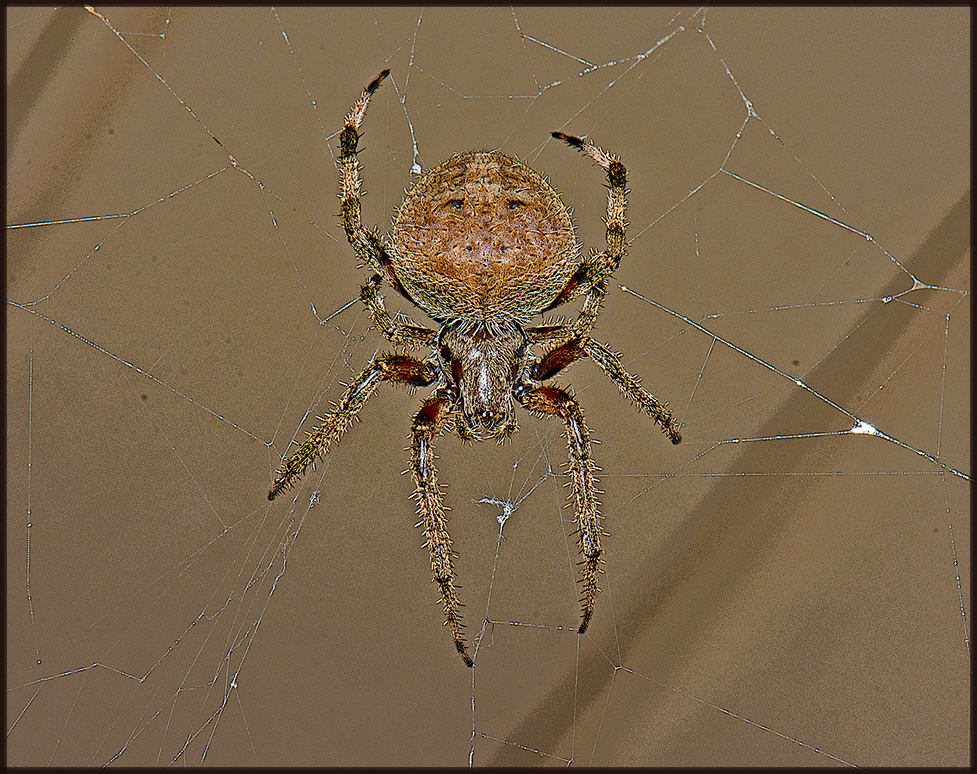
The Orb Weaver
We don't know much about spiders, but we can say we have made our peace with the legion of spiders who hang-out here at 3 Dog Acres. We agree to not smash them. They agree to not frighten us — and pretty please, do not bite. It's a workable agreement. Arachnophobia? No. Rather, we fess-up to a visceral reaction to the surprise appearance of a spider — the bigger the spider, the stronger the reaction, especially when those huge jumping spiders burst out of the closets. They jump. We jump. And if one comes too close to bed, couch, chair, or desk, we catch her in a drinking glass and release her into the wild. That's gotta be scary for the poor spider.
The critter pictured here spun her web next to a bedroom window (outside) late last summer. She kindly posed for the photograph. Then our friends at Bug Guide dot net identified her as Neoscona crucifera, aka Barn Spider, aka Hentz Orb Weaver. Neoscona, we are told, combines the Greek neo = spinning and scona = in the reeds … hence spinning in the reeds. Crucifera is more obvious, meaning cross (noun) or crucify (verb). Sources tell us the creation of the genus-species name for our Orb Weaver dates all the way back to 1864 — and that the Greek was a tad mangled. Schoinos is the correct Greek term, but the youthful arachnologist who devised the name was only 16 at the time. We'll give him a break.
Apparently, it isn't easy being a spider. “In point of fact, spiders appear to live continually in dread of enemies, and their whole life is spent in a defensive industrial warfare for the protection of their persons, or in offensive war upon those insects which furnish them their natural food,” Henry Christopher McCook, D.D., wrote in his 1889 textbook American Spiders and Their Spinningwork: A Natural History of the Orbweaving Spiders of the United States. “In the former case they are habitually in hiding; in the latter, in ambush.”
3 Dog Acres | rural Washington County, Aransas
Image by Ebenezer | 16 August 2019
The Great Oaks of Home
They're Simpatico to Me
By Ebenezer Baldwin Bowles
23 June 2020
Digression: News about Trees
Eventually you realize the better days are behind you, but you refuse to surrender to the finality of it all, preferring to embrace the moment as long as it may last. I'm embracing that moment now, reflecting on the family of oaks who encircle Crow's Cottage, transforming the hacienda into a welcoming bower. Each homestead tree is simpatico to me.
I've not taken the time to nail down the species names of each oak, taking satisfaction in the lumberman's red oak/white oak dichotomy — not that I'd ever, ever even never consider transforming these welcoming giants into lumber. At times I'm just a lazy amateur arboriculturist.
One of our neighbors insisted that the oaks be cut down because of their proximity to the hacienda. He said they are dangerous, might fall on us, damage the house or worse, and I said the only danger here is your attitude. We don't get along, my neighbor and me. He's always trying to convert me to his religion.
Truth Be Told, We Live in the Woods
Grandmother and grandfather oaks live out front, the former defining the southern-most boundary 'twixt the neighbor's land and ours, and the latter standing tall and wounded about thirty-feet from the front door. I say wounded because grandfather suffered severe injury to limb and branch during a fierce ice storm a decade or more ago. He is recovering as best he can with each passing season. I'm sure he shall outlast we mere humans. He and his mates are the central source of all vegetable power.
Ruth the red oak lives about fifteen feet from the north facing kitchen window. She is a rare beauty. Themis rises from the Earth even closer at the northwest corner of our bedroom. Oliver, whose name comes from the poet Mary Oliver, stands tall … about twenty-feet from the west-facing bedroom, while her good friend Atlas stands a mere ten feet from the southwest corner of the same room. It's a long room, our bedroom, about thirty feet in length with a western wall of tall, narrow windows.
Truth be told, we live in the woods and make friends with all the nearby trees, believing they work together to protect one another from high winds and strong storms — and by protecting one another, they protect us, too.
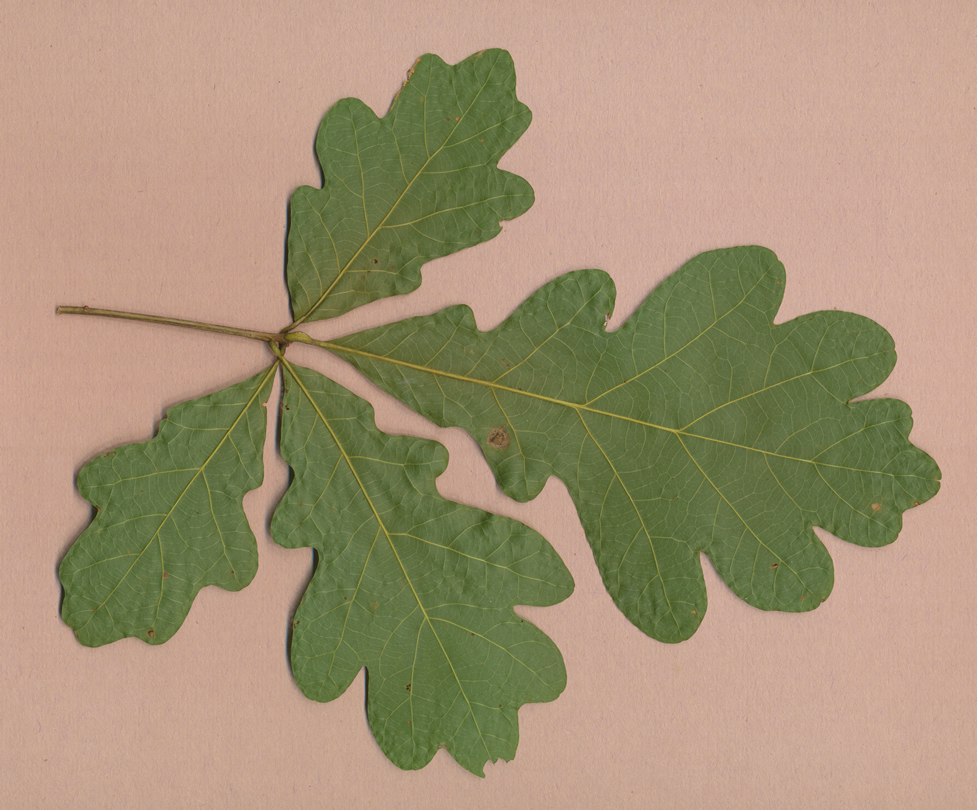
White Oak Leaves
3 Dog Acres | rural Washington County, Arkansas
Image by Ebenezer | 14 July 2017
Reforestation in Sudan
We are not alone in our affinity for trees — I'm certain you share that affinity. You wouldn't be here tangled-up in this string of words unless you bear witness to the spirit of the naturalist. That being true, let's share some current news about trees and forests.
A semi-arid stretch of desolate land in Sudan's White Nile state is the focal point of a massive reforestation project covering 2,500 hectares (about 6,200 acres) previously stripped of its mature trees for firewood and construction materials. Since its inception in 2017, the project has planted an estimated one million saplings of four Acacia species — with several million more on the planning table.
Intertwined with the project is the presence of nine camps hosting 200,000 South Sudanese refugees, who forage for scarce firewood and sometimes fell trees in unsustainable quantities to build shelters in the camps. “Our plan this year is to set up woodlots or smaller forests around each of the nine camps to replace the trees cut down by refugees over the years,” Imadeldin Ali, a United Nations officer said.
Having the reforestation project close to the nine camps will help protect refugee women from sexual violence, who sometimes must trek for hours to forage for scarce firewood. “It's promoting safe access to sustainable cooking energy while addressing environmental challenges,” Mr. Ali said.
Acacias in Cocoons
The Al Jabalain Tree Nursery produces about 200,000 saplings a year for the project, which has inspired an innovative procedure to help the saplings survive summertime temperatures climbing as high as 115 degrees Fahrenheit.
The Acacias babies are enclosed in cocoons that improve their survival rate by 75 to 95 per cent, according to reliefweb.int. “The cocoon is a biodegradable incubator designed to support a sapling through its critical first year by providing water and shelter while stimulating a healthy and deep root structure, tapping into the water supply beneath the surface,” the United Nations reports. “The cocoon stores water for about three months, enabling seedlings to get through to the rainy season. This results in independent trees that can survive in harsh conditions.”
To be clear, a slew of agencies are involved: the UN Refugee Agency, the Forests National Corporation of Sudan, Innovation Norway, and the Dutch Land Life Company. Nonetheless, it is the refugees and their diligent hosts who will determine the long-term success of this innovative project. SOURCE: OCHA Services reliefweb
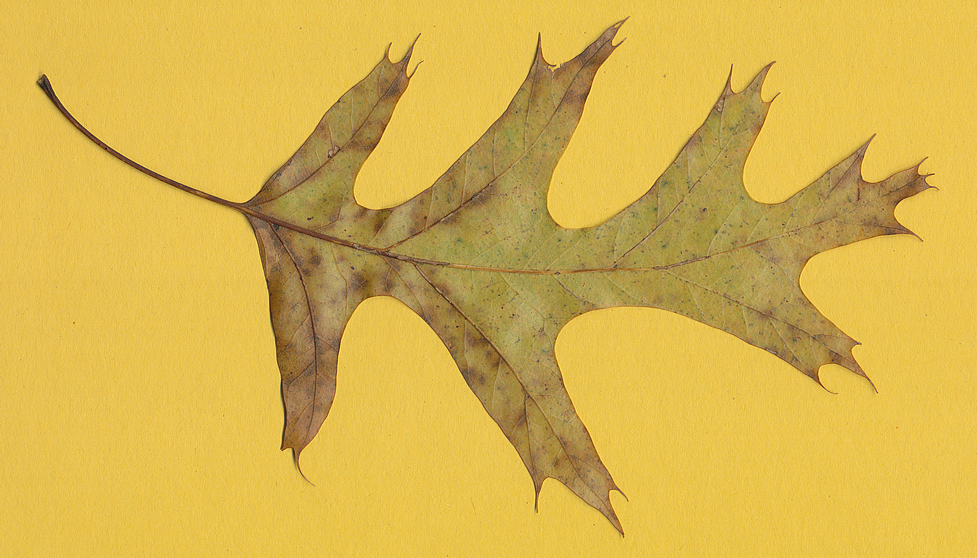
Red Oak Leaf
3 Dog Acres | rural Washington County, Arkansas
Image by Ebenezer | 5 November 2019
Our original plan was to say goodbye to Sudan and turn our attention to the great forests of northern Russia. There a nuclear physicist has developed a controversial theory that water vapor exhaled by trees in Russia's boreal forest — the largest forest on Planet Earth — whip up their own winds — winds strong enough to carry water across continents and around the world. It's a tale that deserves a closer reading, but not tonight. The hour is growing way late. We've written more than enough for one session. Russia can wait. When I stroll the gardens tomorrow, I'll give Ruth a big ole hug and tell her it comes directly from you.
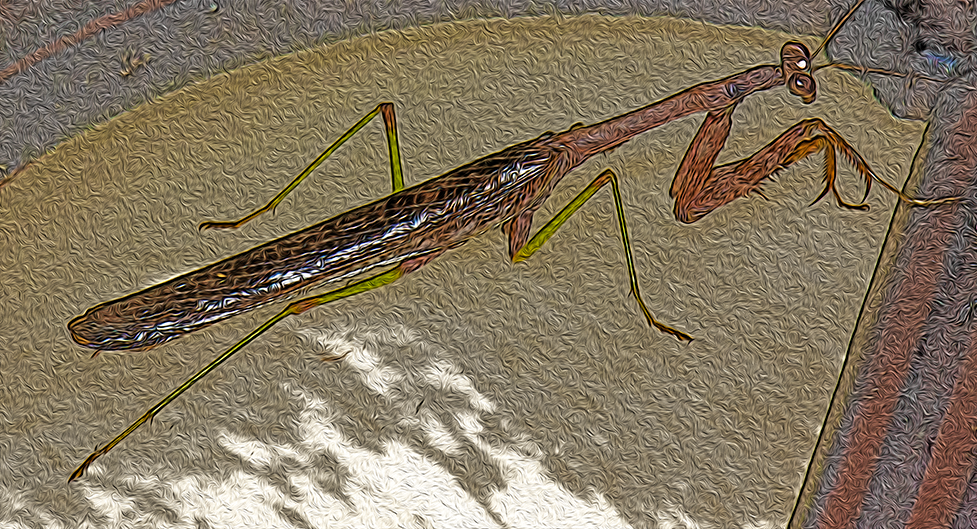
The Soothsayer
“In the life of the celebrated missionary, St. Francis Xavier, we read ‘that when he saw a Mantis holding up its arms in deep devotion, he asked the insect to sing the praises of God, whereupon it chanted a very fine canticle,’” Benedict Jaeger writes in The Life of North American Insects (1859). “They dwell upon the leaves of trees and bushes, walking very slowly upon their four hind legs, or sitting stationary for hours, like the chameleon, waiting for their prey. As soon as they perceive a fly or a caterpillar approaching, they turn their head on all sides, watching its movements, then they creep toward it slowly, like a cat after a mouse, until, with the rapidity of an arrow, they pounce upon it and grasp it with their sharp-pointed fore feet. Having devoured their victims, they resume their former positon, and sit stationary, holding up their fore legs as if in the attitude of prayer.”
Should we consult the Greek? Why not? Mantis translates to prophet or soothsayer as in “one who divines.” Professor Jaeger calls the Praying Mantis a “cowardly and cruel insect, which is itself afraid of a little ant.… These insects, according to the observation of all naturalists, are very warlike and voracious.… To witness the warlike disposition and cruelty of these soothsayers, it is only necessary to put several of them in a box together, when they will immediately commence fighting, furiously striking at each other with the long fore legs.” Maybe we should call them boxer bugs — but who nowadays would catch a passel of Manti, put 'em a boxing ring, and watch 'em fight? No one I know — but then we are dealing with mid-nineteenth century values and sensibilities. Who is the cruel one here? Bug or man? We also note a particularly intense dislike of the Mantis on the part of Dr. Jaeger, who organizes his entry about the Soothsayers next to cockroaches and ear-wigs.
3 Dog Acres | rural Washington County, Arkansas
Image by Ebenezer | 18 September 2019

A ‘Bigger Scale’ Utopia
Running counter to the fragmented character of today's nature restoration projects, WildEast in Great Britain announced this spring a fifty-year plan to transform East Anglica County into one of the planet's great nature reserves. “WildEast aims to become Britain’s first regional nature recovery project, returning 250,000 hectares of land to nature, and potentially seeing the reintroduction of species such as beavers, bison and the Eurasian lynx,” Chris Hill writes in the Norwich Evening News of June 13.
WildEast aspires to a total transformation of the natural realm in East Anglica, moving away from the current model of discrete islands of conservation toward a more holistic and interconnected plan, uniting the whole of the county through wildlife corridors and green bridges for animals to cross major roads. “The core ambition is to reverse the alarming declines in insect, mammal, and bird life and restore natural abundance to levels not seen since the 1970s,” Mr. Hill writes. “Over time, it is hoped the project will gather momentum and become a catalyst for change on a landscape scale — educating children, reconnecting the public with nature, and uniting fragmented conservation agencies, farmers, business communities, and individuals.”
The ‘Bigger Scale’ idea stands in stark contrast the present state of disconnected conservation efforts. “We need everyone to be engaged, we need allotments, churchyards, backyards, and farmyards all doing their bit for nature rather than just a Wildlife Trust reserve or a big farming estate,” Lord Hugh Somerleyton said. "We are looking at an area of 1.25 million hectares. Not only does that make us an area as grand in scale and vision alongside any of the great conservation projects around the world, but it underlines the point that this scale of thinking is exactly what is missing from nature conservation in this country. We need to think on a bigger scale. There will be corridors running across that area and nature hotspots and we all need to be doing our bit to provide a better chance for all wildlife to be restored to abundance.” To read the entire story, click here to be transported to Norwich, England. "


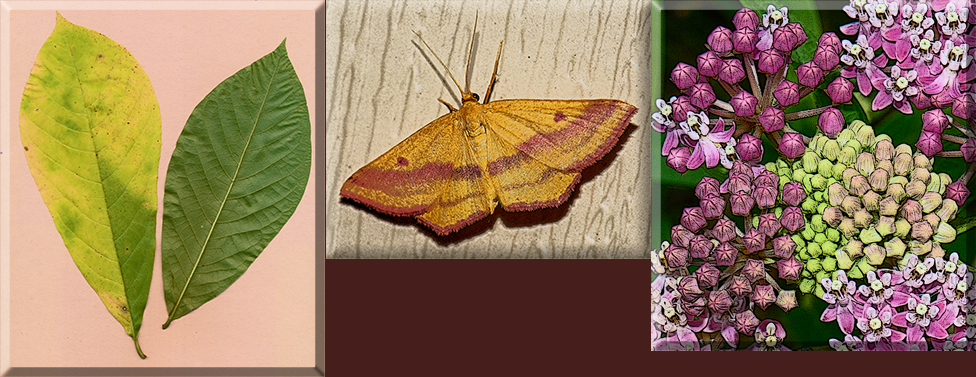
Paw Paw, Chickweed, Milkweed
We encountered the paw paw and moth here in the gardens of Crow's Cottage. The milkweed was growing near the entrance to Woolsey Wet Prairie in Fayetteville. As for the moth, our friends at Bug Guide dot net helped identify the little beauty as Haematopis grataria, street name Chickweed Geometer. The comely moth paused from its nightly hunt for flower nectar and dog fur, resting on the outer wall of the hacienda not far from the porch lights. As for the common milkweed, aka Asclepias syriaca, she's rich in buds that soon shall open to reveal a sumptious feast for hungry monarch caterpillars who happen to wander by. The paw paw leaves are about twelve inches long.
Image by Crow's Cottage | Summer 2019

Meteorology and Hydrology
Of the Beaver Lake Watershed
Dan Skoff and John Balgavy teamed up on June 18 to address members of the Beaver Watershed Alliance in the 2020 Speaker Series via Zoom. Under the title “Meteorology of the Ozarks and the Hydrology of Beaver Lake,” Mr. Skoff and Mr. Balgavy discussed weather events and patterns, water clarity, flood stages and dam operations, competing interests, waterfront developments, population pressures, and overall systems management.
Mr. Skoff, chief meteorologist for KNWA and Fox24 television stations, discussed historical weather patterns and their impact on the Beaver Lake watershed. “The weather has been going crazy, and I've been dealing with all this,” Mr. Skoff said. “Are these flooding events becoming more frequent? Extreme flooding events have been on the rise the past ten years.”
Mr. Balgavy, retired Deputy Chief of Engineering and Construction Division with the Little Rock District U.S. Army Corps of Engineers and a geotechnical engineer by trade, discussed authorized purposes on the lake. 1) Flood Risk Management, 2) Hydropower, 3) Water Supply, 4) Minimum Flow, 5) Fish and Wildlife, and 6) Recreation. The Beaver Lake pool was filled in 1964. He said what's changed in the half century since is development with more paved surfaces and more grass surfaces than we used to have. For any given rain event, he said, more water is getting into the lake and getting there faster.
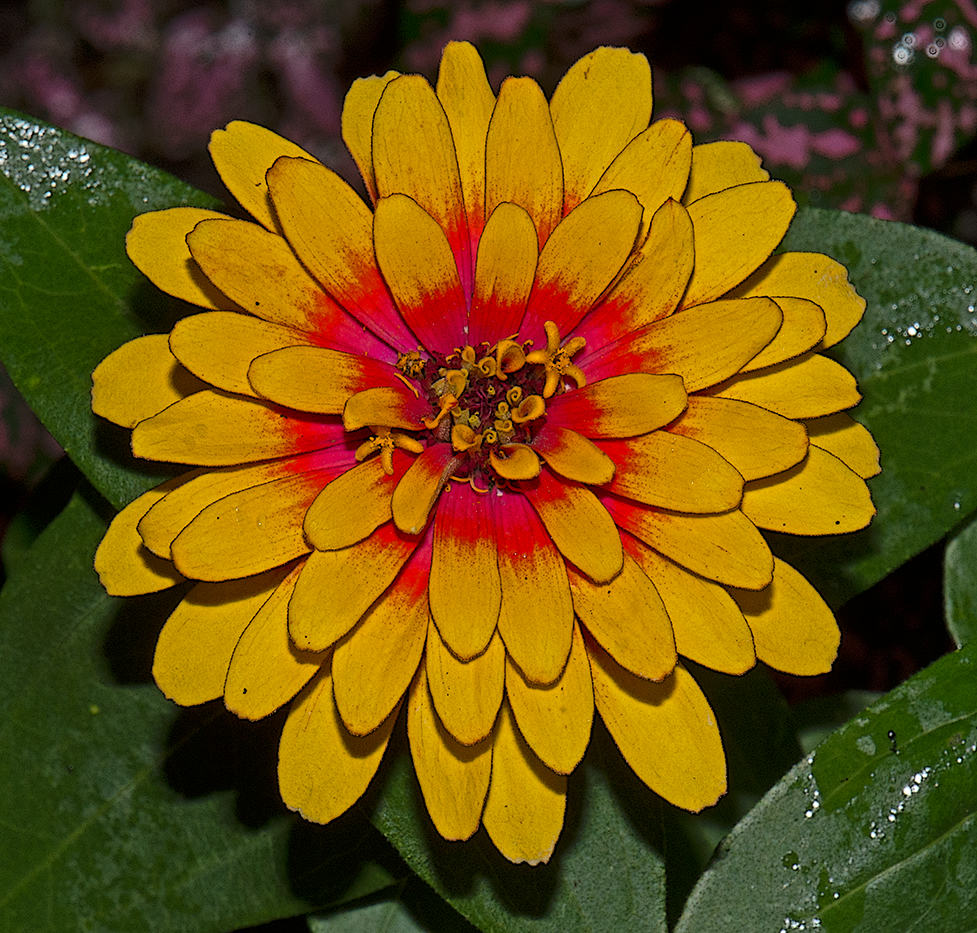
The Fair Dahlia Bright
Let's begin with a passage of poetry from the pen of James Jennings in his 1828 treatise Ornithologia, or The Birds: A Poem in Two Parts; with An Introduction to Their Natural History; and Copious Notes.
Of the Beauties of Flora which rise in their pride,
‘Midst the rocks fertile crannies — the streamlets beside—
Or in soil rich and deeper adown thrust their root,
While their corols of splendour on lofty stalks shoot,
Description, how vivid soe'er becomes faint,
When attempting such tropical glories to paint.
Yet we may not neglect the fair Dahlia bright;
Nor her the fam'd Cactus who blooms in the night;
Nor the Fuchsia, with red and with frutescent stems,
And with florests depending like bright crimson gems;
Nor the Aloe who sits on the rock all serene,
Unfolding her leaves long and thick and pale green.
We are told by a reliable source that the dahlia expresses herself through forty-two accepted species. True enough, but tonight we are thinking about a solitary dahlia, the one pictured here — and we shall call her Dahlia variabilis — and be done with it. ASIDE: The word “corols” is an obsolete botanical term for today's “corolla.”
Nineteenth century botanists and naturalists were smitten mightily by the dahlia, none moreso than Sir Joseph Paxton, the famed architect and landscape gardener who designed the iconic Crystal Palace in England. Sir Paxton in 1838 penned and published A Practical Treatise on the Cultivation of the Dahlia, in which he tells us that another famous naturalist, the German botanist Alexander von Humboldt, brought the dahlia back from “the high sandy plains of Mexico, but in what year we have no authentic accounts.”
The comely flower caught on quickly with gardeners and botanists in the British Isles. Soon there existed a serious set of cultivars — with more on the way every new season. “What abundant cause have we for wonder and astonishment that each succeeding year produces some fresh beauties to admire; each revolving season develops some new peculiarities of shape and colour; every annual catalogue apprises us of immense accessions to our previous stock; and we are involuntarily led to exclaim, ‘Where will all this terminate?’”
Sir Paxton took a deep breath and then gushed some more: “Who would have supposed, that from one comparatively insignificant plant, such endless and innumerable beautiful varieties could have been produced? What will not the skill and ingenuity of man effect even in the vegetable world! It is not unreasonable to imagine, that, ere long, we shall have Dahlia flowers containing infinite combinations of those rich, clear, and exquisitely beautiful colours, for which the tulip has been so long and deservedly admired.”
3 Dog Acres | rural Washington County, Arkansas
Image by Ebenezer | 25 July 2019



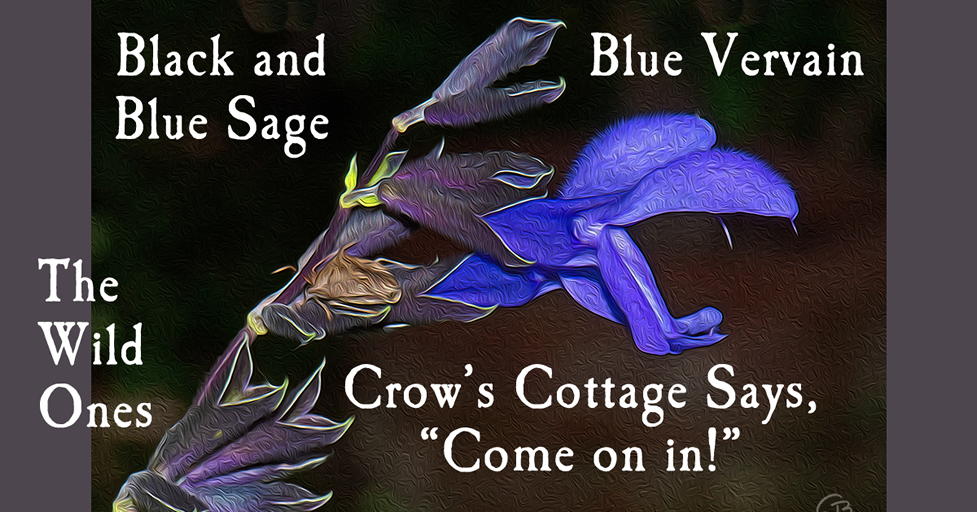

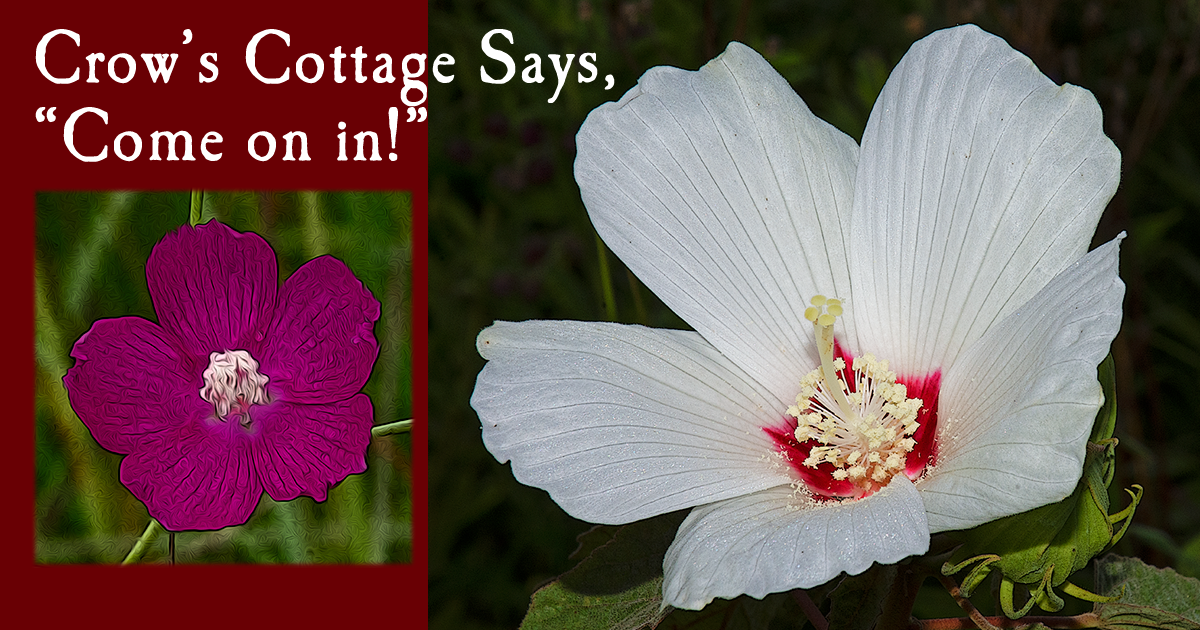


As always, we invite you to write us letter of encouragement or correction. You can even chastise us if you're respectful. Expect a courteous and timely reply. And let us know if you'd like to receive a notice about new features. Our address is ebenezer@crowscottage.com




